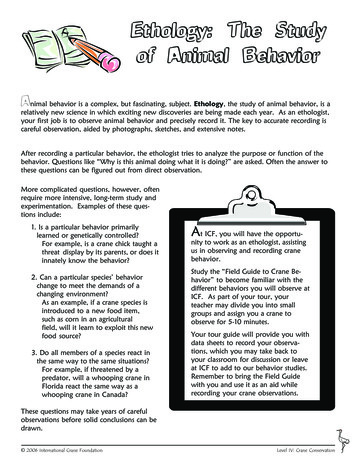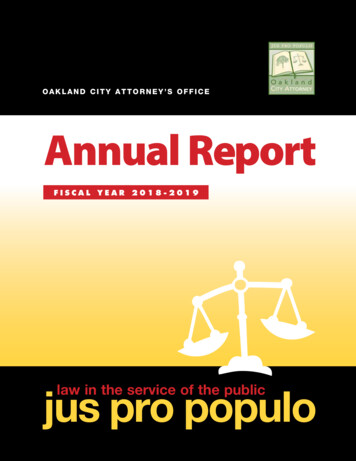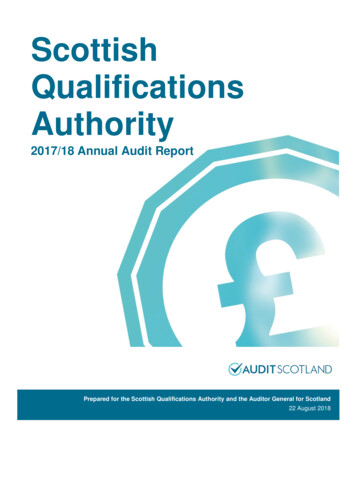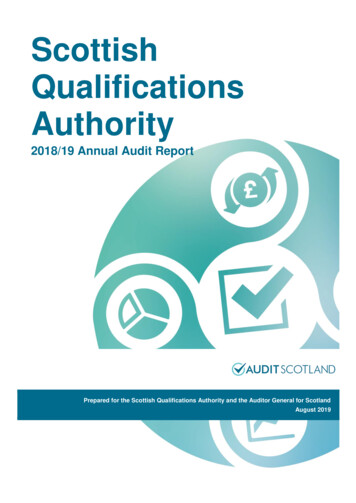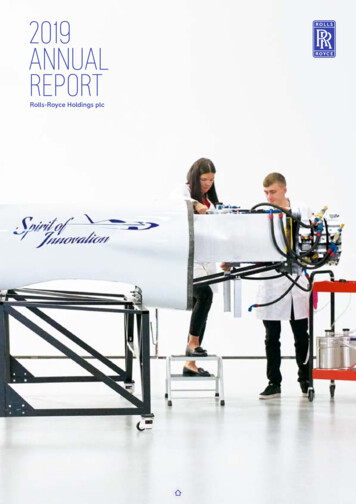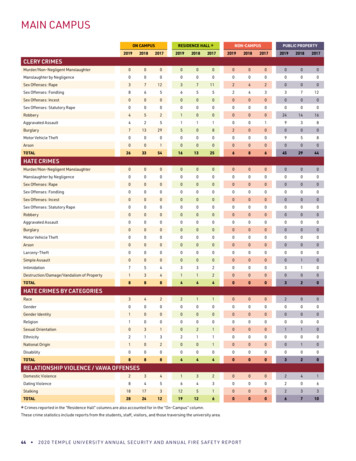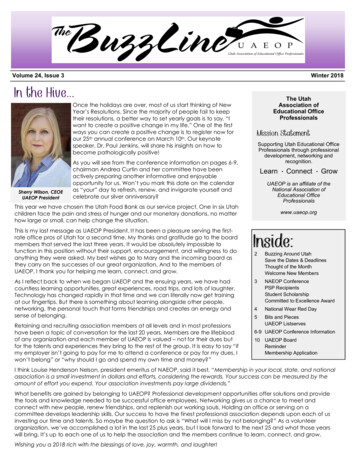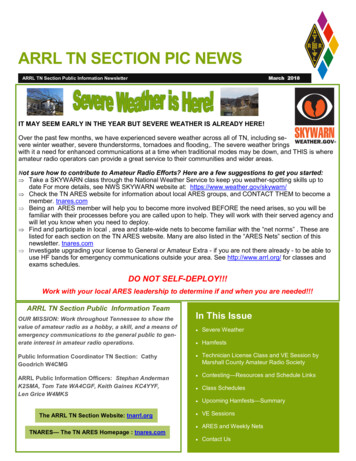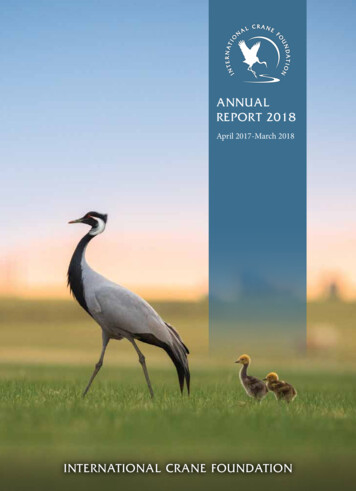
Transcription
ANNUALREPOR T 2018April 2017-March 2018INTERNATIONAL CRANE FOUNDATIONInternational Crane Foundation - 2018 Annual Report
Did you know that wild Whooping Cranes – once reduced to just 21birds – now number over 700? That China has designated 46 National CraneNature Reserves, protecting five species and 71 million acres of land? Or, that 17crane festivals, from Mongolia to New Mexico, bring together many thousands ofpeople to celebrate and safeguard our endangered cranes?On these pages, we share stories from our conservation efforts in Africa, Asia, andNorth America. By working strategically with partners around the world, we haveachieved tremendous impact for cranes and their landscapes. We work in some ofthe most rapidly developing places, like northeast China and the coast of Texas. But we alsowork in some of the poorest places on earth, like the farmlands of East Africa and SouthAsia. Across all these lands, we have learned that genuine conservation solutions requireidealism and pragmatism. In some places, our work leads to strictly protected areas, and inother places, we help communities sustainably harvest and market natural wetland productsto improve each family’s standard of living.We hope you will enjoy this collection of highlights and numbers, but more importantly, wehope you are proud of the investment you’ve made in saving cranes. Your support makespossible our efforts to resolve threats to cranes, ensure healthy landscapes, bring peopletogether, improve livelihoods, empower future leaders, take action based on science, andrestore cranes to the wild.Please continue to support the International Crane Foundation as your trusted partner inconservation. Together, we can save cranes and the places where cranes dance.IMPACT by the NUMBERS!THREATS TOCRANESBy working strategically with partners around the world, we are able tohave tremendous impact for cranes and their landscapes. Our seven keystrategies keep us laser focused on our conservation mission.7key strategiesPartnerships in 60 countries covering 5 continentsRESOLVINGTHREATS TOCRANESENSURINGHEALTHYLANDSCAPESMore than 90,000 Sandhill Cranes in the eastern population after nearextirpation in the 19th centuryMore than 200 Grey Crowned Cranes rescued from illegal captivityOver 1,500 miles of power lines marked or buried to prevent fatalcollisions in South Africa, Bhutan, and the U.S.Over 505 Whooping Cranes in the natural flock from a low of just 21232,000 acres of critical wetlands protected in Africa throughConservation Agreements46 National Crane Nature Reserves protecting five crane species and 71BRINGING PEOPLETOGETHERIMPROVINGLIVELIHOODSmillion acres in China17 crane festivals around the world celebrating cranes and theirlandscapes1,277 dedicated volunteers23,448 visitors at HQ in 2017 engaged in crane conservation8,817 members actively supporting conservation400 households supported through sustainable handicraft productionfrom Phu My wetland in VietnamWith gratitude,Richard BeilfussPresident & CEOOur work isfocusedonRESOLVINGEMPOWERINGFUTURE LEADERSUrban LehnerChairman of the Board of Directors8 conservation-friendly beekeeping coops protecting wetlands andsustaining 112 families in Rwanda310 wetland scientists trained through our university network in theMekong DeltaACTION BASED ONSCIENCERESTORINGCRANES TO THEWILD16,545 image, audio, video, and scientific document files in our digitalasset management system111 rare cranes in our species bank as a hedge against extinction143 reintroduced Whooping Cranes in the wild45,000 social media followers25 years of aerial surveys of key wetlands in southern Africa192,000 acres of cropland treated in 2017 with natural bird deterrentAvipel to reduce conflict with farmersMore than 960 interns trained in field ecology, captive management,educational outreach, and much moreCover photos of Demoiselle Crane with chicks in Mongolia by Ciming MeiInternational Crane Foundation - 2018 Annual ReportInternational Crane Foundation - 2018 Annual Report1
WHY CRANES?Our Work Is AboutLife on EarthûGood question – here’s whyCranes unite us.The universal appeal of cranes as symbols for conservation brings peopletogether and inspires enthusiastic action to resolve broader conservationchallenges that matter deeply to everyone. Cranes are internationalambassadors for peace and goodwill and serve as a flagship species forsome of the most important places on Earth. Together, we can find newpathways to sustain our water, land, and livelihoods.Help us save cranes and the amazing places where cranes dance!With 11 of 15 species threatened with extinction, cranes are among the most endangered families of birdson Earth. From bringing back the Whooping Crane from the brink of extinction to reversing the declineof endangered cranes in Asia and Africa, our efforts ensure that cranes will always grace our planet.But the work of the International Crane Foundationis about so much more than cranes. Our work is aboutlife on Earth.Healthy IndicatorsHighly dependent on healthy wetlands and freshwater,cranes are excellent indicators for the state of ourenvironment. To save the Wattled Crane, we areundertaking the largest wetland restoration project inAfrica. We are removing thousands of hectares of invasiveshrubs and improving water conditions in the Kafue Flatsof Zambia to meet the ecological needs of cranes andmany other rare and threatened species.Goodwill AmbassadorsTraversing international boundaries and uniting peopleacross countries, cranes are ambassadors for peace andcooperation. Sharing a passion for cranes, we bringtogether scientists and conservationists from North andSouth Korea, India and Pakistan, Russia and China –more than 60 countries on five continents.Flagships for ConservationCulturally revered across much of the world, cranes areunique flagships for saving some of the most beautifuland diverse places on Earth. Our efforts to secure PoyangLake in China benefit thousands of water birds, includingmost of the world’s population of Swan Geese, Yangtzedolphins, and water deer, not to mention the livelihoodsfor thousands of people.Photo by Ted Thousand2International Crane Foundation - 2018 Annual ReportInternational Crane Foundation - 2018 Annual Report3
RESOLVING THREATS TO CRANESHIGHLIGHTS OF OUR WORKApril 2017- March 2018RESOLVINGTHREATS TOCRANESCrane Custodians in UgandaWildlife Crime WorkshopIn our quest to secure crane breeding sites on small,household-managed wetlands in Uganda, we initiated thecrane custodianship program where volunteers take up theresponsibility of caring for “their” cranes. The goal is to increasethe breeding success of endangered Grey Crowned Cranes– the national symbol for Uganda. We provide training andequipment to the custodians for monitoring and recordinginformation about nesting cranes. We also educate them onthreats such as illegal domestication, egg removal, poisoning,and power line collisions. Our custodians have proven timeand again to be powerful advocates for wild cranes livingin close proximity to people who share their wetlands. Webring the custodians from different areas together so they candiscuss their successes and challenges, and we are organizingcelebratory events to raise awareness in the community.In early 2017, a workshop on wildlife crimetook place in South Africa. The goal was toincrease awareness about wildlife crimes suchas poaching, trespassing, and related legislation.Wide-ranging attendance included members ofthe South African Police Service, MpumalangaTourism and Parks Agency, the Departmentof Environmental Affairs, Gert SibandeDistrict municipality, Chrissiesmeer ProtectedEnvironment Land Owners Association, andcommunity representatives. We collectedinformation on the community’s perceptions ofwildlife crime to develop solutions to minimizeconflicts between farmers and residents ofChrissiesmeer.This Tastes Yucky!To keep our abundant Sandhill Cranes flourishing onfarmlands, we must find new ways to counter theirimpact on the farmers’ bottom line. We are workingwith state representatives across the political spectrumto help compensate farmers for their investment inAvipel, a non-toxic seed treatment we helped developthat prevents cranes and other wildlife from damagingnew corn seedlings without harming wildlife.Outreach to Safeguard RareWhooping Cranes is WorkingIllegal shootings are a threat to the fragile recovery ofthe Whooping Crane. We are working hard to mitigatethe factors that contribute to these events throughoutreach and education in states with a high precedenceof shootings and by strengthening punishments forconvictions. We are creating communities that careabout Whooping Cranes with our awareness campaignsin Alabama, Indiana, Texas, and Wisconsin. The winterof 2017-18 was the first in ten years without a shooting.In the next year, we will reach out to partners acrossthe central flyway to continue to expand our outreachprogram to safeguard Whooping Cranes.4International Crane Foundation - 2018 Annual ReportInternational Crane Foundation - 2018 Annual Report5
RESOLVING THREATS TO CRANESDid Hurricane Harvey Affect Whooping Cranes in Texas?Our long-term monitoring of water and food availability for WhoopingCranes in coastal Texas became an important benchmark to evaluatethe impact of Category 4 Hurricane Harvey that directly passedthrough the Whooping Cranes’ wintering range. Working withpartners, we employed a rapid assessment of freshwater quality in 33ponds inundated with saltwater from the storm surge and provided aprioritized list of solar wells needing repair prior to the arrival of thecranes from their breeding grounds in Canada. Our efforts reduced theimpact of the storm by providing sufficient fresh water for the cranes.Remarkably, coastal marsh conditions were exceptional with plenty ofblue crabs and wolfberry fruits throughout most of the winter. Althoughimpacts to the coastal communities of Fulton, Port Aransas, and ouroffice in Rockport were devastating, the natural environment did notexhibit negative impacts. Increased storm flows from the coastal riverscarried freshwater loaded with nutrients, sediment, and small debris thatincreased productivity in the bays in the six months after the hurricane.We are grateful to Leiden Conservation Fund, USFWS, Mary Kohler,The Brown Foundation, Houston Zoo, Trull Foundation, Susan VaughanFoundation, Jacob and Terese Hershey Foundation, and Robert L. Pattonfor supporting these efforts.6International Crane Foundation - 2018 Annual ReportENSURINGHEALTHYLANDSCAPESClimate ChangeCranes are one of the most endangered families of birds in theworld, and highly vulnerable to climate change – especially inthe places where habitat loss, water resources development,and invasive species are already taking a toll on cranes. Andcranes are important flagships for environmental changes. Inthe Zambezi River basin, we are challenging river developersto incorporate climate change into the design and operationof new dams, encouraging environmental flow releases fromexisting dams, and seeking energy alternatives more resilientto climate change and less harmful to river users and wildlife.In seeking to better manage water resources in the face ofclimate change, we draw from important lessons gained fromtwo decades of engagement – that the needs of people, and theneeds of cranes and many other species of plants and animals,are often surprisingly compatible and linked strongly to healthywetlands and watersheds.International Crane Foundation - 2018 Annual Report7
ENSURING HEALTHY LANDSCAPESENSURING HEALTHY LANDSCAPESAlthough people said the vast Zhalong Marsh in northeast China could never be crossed on foot, ourcrane biologist in China, Dr. Su Liying, devised a transect route across the widest and most crane-richportion. Every year since 2007, Liying has led a scientific team for three arduous days of walking acrossZhalong Marsh to collect information. Ten years of data trace the results of wetland restoration andrecovery. Already it’s clear that vegetation has responded to better water conditions. But the birds havelagged behind. Liying and her students are analyzing ten years of data to prepare recommendations oncontinuing marsh and crane recovery.Historic Survey of Sarus Cranes in MyanmarIn 2017, we collaborated with Yangon University to conductSarus Crane surveys at 76 villages in nine townships, covering13,500 square miles of the Ayeyarwady Delta. It was the mostcomprehensive survey of Sarus Cranes ever done in Myanmar.We monitored 67 Sarus Crane breeding sites in the AyeyarwadyDelta. Over 80 percent of nests were successful with 102 chickshatched. Our surveys showed that Sarus Cranes are usinga traditional kind of rice paddy, one that is often low-lying,flooded longer, and planted with only one crop of rice per year.This type of rice field also supports a rich diversity of wetlandplants and animals. Sarus Cranes serve as an indicator speciesfor these healthy agro-ecosystems, but these wildlife-friendlyrice fields may disappear in the near future as farmers switchto a more intensive rice farming system. An urgent need existsfor preserving this type of rice farming system in the Delta. Weare working with Myanmar and international partners to findsolutions for protecting these ecosystems.8International Crane Foundation - 2018 Annual ReportPau TangWalking ZhalongThree-year Survey Completed in Cambodia and VietnamIn 2017, we completed a three-year research project on wetlands of deciduousDipterocarp forests in Northern Cambodia and the Central Highland ofVietnam. These wetlands provide breeding habitat for the Eastern Sarus Cranepopulation in Cambodia and Vietnam. We collaborated with four universitiesto survey approximately 500,000 acres of Dipterocarp forests in both countries.In addition to locating and describing wetlands and crane breeding sites, wealso documented the fish and bird diversity of the wetlands. These wetlandsare important for cranes but also for many endangered species such as GiantIbis, White-shouldered Ibis, Asian Elephant, and a species of wild cattle calledBangteng. We provided the Ministry of Environment Cambodia with ournew research findings of wetland ecosystems in Northern Cambodia for thedevelopment of the wise use of wetland policy for Cambodia. We are grateful tothe Stockholm Environment Institute, Sweden for supporting this work.International Crane Foundation - 2018 Annual Report9
BRINGINGPEOPLETOGETHERZhou Hai YanBRINGING PEOPLE TOGETHERPassport to PoyangThe Siberian Cranes at Poyang Lake in China are reveredfor their beauty and rarity and are a favorite subject ofphotographers. This brings economic benefit to the area,but currently there is very little management of visitors.Bird watchers, tourists, and photographers often approach the cranes too closely and disturb their feeding.We want people to experience the cranes in a way that does not disrupt them. And, we want SiberianCranes to be valued for bringing eco-tourism and boosting the local economy. We are developing a modelvisitor program that can be replicated at other sites within the watershed. We have two new environmentaleducators who are training local guides, and we established an environmental education center. We areproviding binoculars and spotting scopes so people enjoy thecranes from a distance. New educational signage at viewinghotspots instructs visitors how to reduce human disturbance insensitive ecosystems.Poetry in the PrairiePoetry in the Prairie was a season-long celebration of cranes and thelandscapes they need to survive. A poetry competition kicked offthe event. We received entries from poets ages 9 to 90! A selection of35 poems was printed on outdoor material and installed throughoutthe prairie habitat our headquarters. Visitors encountered thepoems as they viewed cranes and toured the site. Wisconsin’sPoet Laureate gave a public presentation about the project at ourCranes of the World Festival. Our poetry exhibit culminated witha poetry reading during our annual Membership AppreciationDay in September. This project was funded by a grant from theSauk County UW-Extension, Arts & Culture Committee and theWisconsin Arts Board with funds from the State of Wisconsin.10International Crane Foundation - 2018 Annual ReportDesigning for Cranes and PeopleOur plans for a newly renovated visitor experience and crane exhibits took anotherstep forward in 2017. Our Board of Directors approved the final layout for larger, morenaturalistic enclosures for each species, complete with a water feature in each. Otherdesign elements include murals that transport viewers to the natural landscapes wherethe species live in the wild. This helps our staff tell the compelling stories of the cranesand our work to ensure their survival in the wild. A new visitor center will providethe gateway as guests journey around the world, meeting our cranes, and becominginspired to join the thousands of members and donors who make our work possible.Destruction of Our Texas Officeby Hurricane HarveyIn 2017, Category 4 Hurricane Harveymade landfall directly over Rockport,Texas, the home of our Texas WhoopingCrane operations. The devastation wasimmense. It was days before we wereallowed to return to the area to surveythe damage. Everywhere, hundreds ofvolunteers cleared debris and deliveredwater and food to the cleanup workers.Our office complex in Rockport wascompletely destroyed. Luckily, the roofhad fallen in such a way that it protectedsome of the office contents. The exterior wall fell over our research boat, shieldingit from flying debris. We salvaged as much as we could from the ruined building.We are thankful to the Coastal Bend Bays & Estuaries Program for offering ustemporary office space in Corpus Christi. We quickly developed research plans toassess the response of the cranes to the hurricane, ordered replacement equipmentand supplies, and made sure our team would be ready for the coming winter season.We are deeply grateful for the generous and rapid support of our members and thefoundations that help us continue our important work.International Crane Foundation - 2018 Annual Report11
Ted ThousandBRINGING PEOPLE TOGETHERCaptive Management of Cranes Through BreedingManaging the only captive flock of all the rare crane species in the world is not a simple task, and we can’t do italone. We work with the Association of Zoo and Aquariums Species Survival Plans for sustainable genetic anddemographic breeding recommendations of the captive collections. In 2017, we produced a rare fertile Whitenaped Crane egg that was sent to the Bronx Zoo to be placed with a pair of surrogate cranes. We also producedfive fertile Hooded Crane eggs and successfully hatched and reared two chicks from one of the most geneticallyvaluable pairs in the North American captive population.Highveld Crane ProjectThe sixth annual Chrissiesmeer Crane Festivalwas held in June 2017. We worked togetherwith local partners in planning the event.Preparations included ensuring local communityparticipation, monitoring the Grey CrownedCrane movements, and working on the logisticsof the festival. Over 150 people attended thefestival. The activities took place at Lake ChrissiePrimary School and participation in activitieswas beyond expectations. Crane mask coloringand the pin-the-crown-to-the-crane game wereparticularly popular. The crane viewing tripswere again well received and raised awarenessabout the status of cranes, habitats, andbiodiversity. We are grateful to HCI Foundationand South32 for funding this work.12International Crane Foundation - 2018 Annual ReportIMPROVINGLIVELIHOODSManaging Waters for Biodiversity andRural LivelihoodsIn Namibia, we joined with water authorities, hydropowermanagers, and water user groups from across southern Africa fora special workshop on environmental flows (sustainable watermanagement for rivers and their floodplains). We teamed up withour colleagues at WWF-Zambia to discuss lessons learned fromtwo decades of advancing environmental flows in the ZambeziRiver Basin for rural livelihoods and biodiversity conservation.Wattled Cranes, with their highly specialized diets and nestingrequirements linked to the natural ebb and flow of floodplains,are an important flagship for sustainable water management. Oneof the most powerful arguments for environmental flows is thateconomic value of water for fisheries, agriculture, livestock grazing,natural resources, and wildlife is higher than the value of thatsame water held back for hydropower generation. On the KafueFlats in Zambia, the massive Zambia Sugar Industry supportsour environmental flows efforts. When the floodplain is naturallyflooded, most of the predatory insects that feed on sugar stay in thefloodplain wetlands, but when floods are withheld or diverted, theinsects abandon the floodplain and attack the sugar plants, in turnrequiring the intensive use of pesticides. It’s all connected!International Crane Foundation - 2018 Annual Report13
IMPROVING LIVELIHOODSIMPROVING LIVELIHOODSOur Conservation Agreements Are Working in Rwanda!Rugezi Marsh is a protected high altitude peat bog located in the Northern Province of Rwanda. Itis a source of water for thousands of people who reside in its catchment. Rugezi Marsh also providescritical habitat for Rwanda’s largest population of endangered Grey Crowned Cranes. Unfortunately,intensive subsistence farming, grazing, and the illegal taking of cranes to sell on the black marketthreatened the health of this extraordinary marsh. We knew that the key to protecting the marsh andits cranes meant addressing the needs of the people who call Rugezi home.We have used the Conservation Agreements model successfully where people and endangered cranesdepend on the same wetlands. Conservation Agreements are negotiated incentive packages thatcommunities receive in return for becoming stewards of their own ecosystems. Beekeeping emergedas a priority livelihood because it creates incentives for protecting the marsh, and honey is a reliablesource of income for rural households in Rwanda. By signing the agreement in 2016, the cooperativesmade a commitment to stop agricultural encroachment such as grass harvesting and livestockgrazing in the marsh. They agreed to participate in monitoring activities and to report illegal activitiesincluding hunting and removal of crane eggs. They also pledged to play a leading role in raisingawareness for the need to conserve Rugezi Marsh.Empowering Local Communities at Poyang Lake, ChinaChanghu Chi is one of nine sub-lakes located within the vast Poyang Lake National Nature Reserve. The localcommunities own this sub-lake. We have been working with Wucheng Town to modify the next lake lease forChanghu Chi to include measures that benefit fish and waterbirds. They will limit the harvest of the smallestfish, ban electroshocking of fish, and minimize disturbance to birds. The lease pledges to consider the needs ofbirds in their water management. Because of these changes, Wucheng will receive less revenue for the lease, butbecause they are a birding hotspot, they know they will benefit more from eco-tourism. We worked with OceanOutcomes, an enterprise fishery consulting organization to conduct a fishery improvement project at PoyangLake where Changhu Chi is a pilot project. We expect to see tangible benefits to fishermen and improvementsto fishery practices that benefit the birds. Effective fishery management in the sub-lakes needs participationby local communities. By improving fishery sustainability and increasing fish prices, the community, cranes,and conservation triumph. We are grateful to Disney Conservation Fund, Erica P. John Fund, and StiftungFeuchtgebiete for funding this work.Each cooperative received beehives, honey processing equipment, training and technical support.Since the signing of the agreement, members of the cooperatives have led coordinated efforts topatrol the wetland, identify and report threats, and document sites where cranes breed and forage.They have mobilized community members to extinguish fires, replant trees in the wetland’s bufferzone, and spread the word about the benefits of wetland conservation. Monitoring of the BeehiveProject is ongoing and honey yields are increasing, a result that is transforming local residentsinto wetland stewards. We are grateful to the John D. and Catherine T. MacArthur Foundation forsupporting this work.Farmer Homestead Restaurants FeedBirdwatchers and Increase Household IncomesThe critically endangered Siberian Crane is a beloveddenizen of Poyang Lake, China. An increasing numberof tourists travel to this impoverished area to view andphotograph the stunning white birds. We have beenworking at Poyang for decades to protect the cranes fromdisturbance, but a more recent goal of our program is tocreate new sources of income for the communities thatshare their landscapes with the rare birds. A popular newinitiative is the farmer homestead restaurants that helpfeed the growing numbers of tourists. Local people valuethe Siberian Cranes for bringing economic benefit to thearea, and their families benefit from conservation-friendlyincome. We are also hiring local people as guides andguards to reduce disturbance.14International Crane Foundation - 2018 Annual ReportInternational Crane Foundation - 2018 Annual Report15
EMPOWERING FUTURE LEADERSFiona to the Rescue!Over the years, we have developed a networkof crane custodians in Western Kenya, astronghold for Grey Crowned Cranes. Amember of the Sio Siteko Wetland ConservationTeam reported an incident of children harassinga family of cranes with chicks. Fortunately, ayoung girl named Fiona was able to save oneof the chicks by hiding it in the wetland. Shetook the chick home and fed it grasshoppersand other insects. Our project leader in Kenyaworked with Fiona to rehabilitate the chick so itcould return to the wild. They invited teachersand students from the local schools to witnessthe chick’s release. Members of the community,including a village elder, were also presentwhen the chick was reunited with its parents.The happy occasion provided the opportunityto talk about crane and wetland conservationwith the students. They promised to spread ourconservation message in the Sio Siteko area.Crane ConnectionsEMPOWERINGFUTURE LEADERS16Improving our Effectiveness in AfricaOur work in East Africa focuses on helping communitieswork together to sustainably manage their wetlands in theface of increasing human pressure and climate change. Inearly 2018, members of the African Crane ConservationProgram (ACCP) and our Conservation Measures Managermet in Uganda and Rwanda for a team building retreatfocused on improving the effectiveness of our work there.ACCP is a partnership between the Endangered WildlifeTrust, based in South Africa, and the International CraneFoundation. The group focused on the concepts of OpenStandards for the Practice of Conservation, a set of bestpractices for evidence-based conservation and adaptivemanagement. We also learned about new crane andecosystem monitoring techniques to better assess ourimpact for cranes and wetland health over time. This retreatwas supported by a generous donation from the DohmenFamily Foundation.International Crane Foundation - 2018 Annual ReportMore than 500,000 Sandhill Cranesconverge on Nebraska’s Platte Riverevery spring – the world’s largestgathering of cranes in one place.This great crane migration is trulyone of the most breathtaking wildlifespectacles in North America. We senttwelve team members, including staffand volunteer tour interpreters andoutreach interns, to participate in theNebraska Crane Festival, experiencethe migration, and enhance their abilityto interpret the ecology of SandhillCranes for our visitors. This experientiallearning opportunity deepened theirconnection to Sandhill Cranes aseducators and scientists. The heightenedawareness and passion engage visitorsin resolving threats to cranes and theirdiverse landscapes around the world.We are grateful to Kathryn Scheer forsupporting this trip.International Crane Foundation - 2018 Annual Report17
EMPOWERING FUTURE LEADERSACTION BASEDON SCIENCESecond Printing for Saving Imisambi!After distributing all 3,000 copies of the first printing of the comic book Saving Imisambi Saving Grey CrownedCranes near Rugezi Marsh and Akagera National Park, we printed another 10,000 books for distribution in andaround Rwanda’s capital, Kigali City. This urban center created much of the demand for the country’s illegally heldGrey Crowned Cranes. Saving Imisambi addresses the challenges faced by the cranes and inspires action. Childrenreceiving comic books at school participate in outreach activities with the Rwandan Wildlife ConservationAssociation. Survey evaluations reveal that critical messages are indeed helping to change attitudes. In pre-outreachsurveys, 44% of students believed everyone had a responsibility to protect wildlife. The number rose to 71% inpost-outreach surveys. Helping children appreciate cranes in the wild as part of their natural heritage is a firststep in reversing the rapidly declining numbers of Grey Crowned Cranes.Over the past 40 years, South Africa’s cranes (Blue, Grey Crowned,and Wattled) have declined drastically due to agriculturalexpansion and human development. Over the last 24 years, wehave been collaborating with KZN Wildlife to fly annual aerialsurveys in KwaZulu-Natal, South Africa, to monitor and recordcrane populations and distribution. Early on, the aerial surveysshowed a steady decline, but understanding the situation helped usidentify the main causes and also how to tackle them. One threatdemonstrated by the surveys was death from power line collision.This led to the formation of a partnership with the power utility,Eskom, to attach bird diverters on power lines in sensitive areas.Identifying problems and fo
International Crane Foundation - 2018 Annual Report International Crane Foundation - 2018 Annual Report Walking Zhalong Although people said the vast Zhalong Marsh in northeast China could never be crossed on foot, our crane biologist in China, Dr. Su Liying, devised a transect route across the widest and most crane-rich portion.
